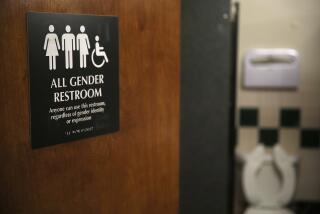What Hot Debate the Feminist Movement Hath Wrought
- Share via
Even before the September/October Mother Jones hit the stands with a scathing critique of women’s studies programs, author Susan Faludi was pounding out a response.
But it would be a stretch to define that article--or what’s being said more broadly in magazines this fall--as mere media backlash against feminism.
Chaos theory might better grasp the countervailing, intersecting, and ricocheting intellectual wave patterns generated by the explosion of cover stories re-evaluating the women’s movement.
“Why do so many women hesitate to call themselves feminists?” the September/October Ms. asks four high-profile users of that label (three of whom still capitalize the first letters of their names).
The MoJo article indirectly answers with another question: “Is feminist education limiting her potential?”
Students from the women’s studies department at UC Berkeley protested last week outside Mother Jones’ San Francisco office--a magazine that until recently was as sacrosanct among progressives (and thus self-marginalizing) as Ms.
That has to be healthy, and when everything shakes out, this magazine season may prove a watershed in the evolution of sexual politics, as publications ranging from Future Sex to Harper’s Bazaar grapple with feminism.
The most prominent analysis appears in the October Atlantic.
In “Feminism’s Identity Crisis,” author Wendy Kaminer reports polls showing that most women agree that feminism has made their lives better. But “a majority hesitate to associate themselves with the movement.”
Kaminer’s piece, though disjointed and rambling, sheds light on a range of issues that most feminists increasingly agree must be discussed, if not reconciled.
Among the often overlapping types she labels: post-structural feminists, political feminists, different-voice feminists, separatist feminists, pacifist feminists, lesbian feminists, careerist feminists, liberal feminists, anti-porn feminists, eco-feminists, and womanists. Her least favorite breed is the personal-development feminist, a tribe allegedly led by Gloria Steinem that, Kaminer says, “puts a popular feminist spin on deadeningly familiar messages about recovering from addiction and abuse, liberating one’s inner child and restoring one’s self-esteem.”
Ms. magazine’s discussion confronts this disunity with the subtitle: “No, Feminists Don’t All Think Alike.”
But at least the better known of the four participants seem to suggest that, dang it all, they should.
Naomi Wolf, ever the peppy student council leader, warns that many women perceive an elitist “club feminism” in the women’s movement. She then condescends: “These women that we would not recognize as part of our particular belief system have a sense of their own outrage.”
Likewise, Steinem, while rhetorically opening her arms to sisters of every stripe, smugly dubs recently indicted Sen. Kay Bailey Hutchinson (R-Texas) “a female impersonator.”
Only bell hooks, an African-American with a truly radical feminist agenda, seems to grasp how damaging the bullies of political correctness have been to the cause.
“The image has been that there’s a party line,” she says. What is needed, though, is “intellectual dissent among women of all classes and men of all classes.”
Steinem boasts about the non-judgmental “respect for individual experience” that guides feminist rap sessions.
“That’s exactly the model that nauseates me,” says hooks. “. . . I’ve seen that model close down dissent, make it appear that all opinions are equal.”
Karen Lehrman found similar sentiments while researching her iconoclastic essay in Mother Jones.
Last spring, Lehrman visited women’s studies courses and departments at Berkeley, the University of Iowa, Smith College and Dartmouth. She came back unimpressed.
The Angry Young Women these programs tend to create, she found, were often ill-equipped to think critically or argue persuasively outside a narrow rhetorical range. They were not, she found, well prepared to enter the non-academic world.
Lehrman attributes this, in part, to the confining range of acceptable political debate in women’s studies programs, where many students confided that they are afraid to speak their mind.
Lehrman’s piece is not as polemical as it might sound. She acknowledges both the importance of women’s studies, and that many programs encourage both scholarship and intellectual debate.
Still, in the programs she encountered, most professors “seem to adhere to the following principles in formulating classes: women were and are oppressed; oppression is endemic to our patriarchal social system; men, capitalism and Western values are responsible for women’s problems.”
“The irony,” she says, “is not only that these students (who at the schools I visited at least, were overwhelmingly white and upper-middle class) probably have not come into contact with much oppression, but that they are the first generation of women who have grown up with so many options open to them.”
Yet instead of pushing themselves to sample the range of options, women’s studies students--male and female--spend an inordinate amount of time getting their consciousness raised--a task, Lehrman argues, better accomplished off campus at women’s centers.
“Young women have many needs,” she says, “and the college classroom can effectively address only one of them: building their intellects.”
Next month, Mother Jones will print 14 letters from the flood of response it received, including Faludi’s.
“Maybe, just maybe,” Faludi says in her letter, “having one’s intuition respected is a bit more crucial to the average young women’s educational growth than mastery of a dead language.”
Or maybe not. Overall, though, Faludi’s impassioned defense of feminism as an ideology misses the point. There would seem to be a rebellion afoot, not against feminism, but against the ideological authoritarianism of the movement’s self-proclaimed elite.
Faludi quotes the book, “Pedagogy of the Oppressed”: “Knowledge emerges only through invention and reinvention, through the restless, impatient, continuing, hopeful inquiry human beings pursue in the world, and with each other.”
But that’s exactly what Lehrman accuses women’s studies programs of suppressing--and it’s exactly what her article and the others (and the responses) encourage.
The question is, how many syllabuses in women’s studies courses will now include the Mother Jones article, and how many only Faludi’s response.
Magazine vs. Magazine
Last February, The New Yorker printed a story about the history of the Beverly Hills Hotel. Writer Adam Gopnik reported a “chance” encounter there with Karen Hudson, a woman whose grandfather had designed much of the landmark.
According to a story by Karen Grigsby Bates in the current Buzz, Hudson read the article and wrote a letter to the New Yorker saying that the encounter had been prearranged, and that other aspects of the story were erroneous.
But, of course, the New Yorker had no letters column, and seldom runs “amplifications.” A New Yorker editor reportedly called, and politely told Hudson to be glad the magazine is weekly and not monthly--that it would go away soon.
Interestingly, this week--the first anniversary of Tina Brown’s arrival--the New Yorker launches a letters column. It’s not particularly stimulating. Readers are advised to skim them, and carefully read Richard Avedon’s portfolio of photographs on the Kennedy years.
More to Read
Sign up for our Book Club newsletter
Get the latest news, events and more from the Los Angeles Times Book Club, and help us get L.A. reading and talking.
You may occasionally receive promotional content from the Los Angeles Times.








